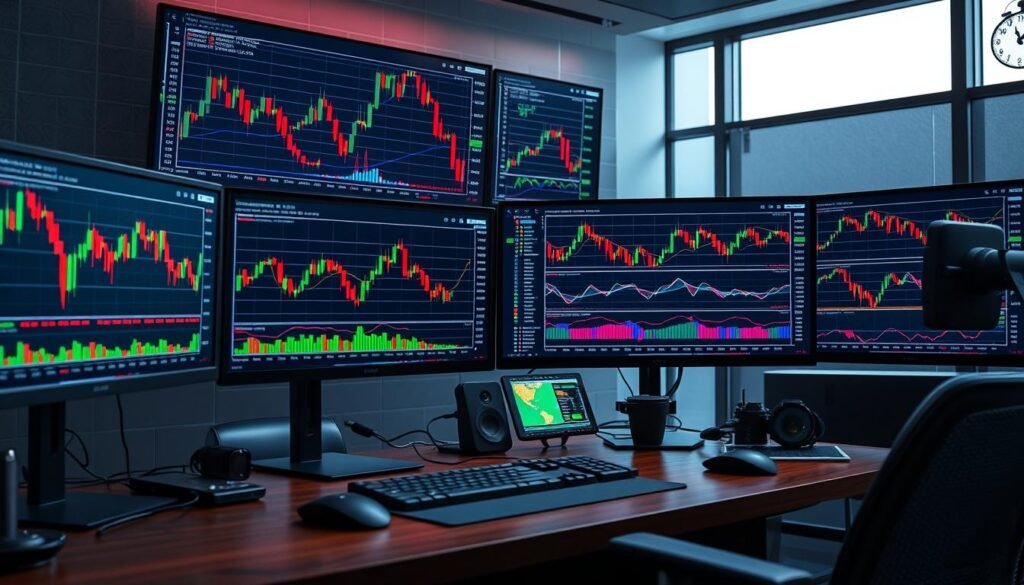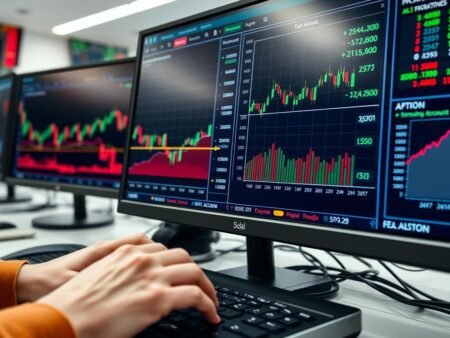Starting your journey in financial markets as a prop trader is both thrilling and challenging. Having access to the latest prop trading firm assessment tools and knowing the best practices for prop trading evaluation is crucial. It’s not just an advantage anymore; it’s a must for success.
Whether you’re new to trading or have years of experience, passing a prop firm evaluation is a big test. It will challenge your strategy, discipline, and ability to analyze markets. This section gives you the top tools and knowledge you need to succeed in today’s leading proprietary trading firms.
Key Takeaways
- Identifying the optimum range of trading tools that align with prop firm evaluation metrics.
- Understanding proprietary trading firm environments and the benchmarks for success.
- Implementing best practices to adhere to a prop trading firm’s stringent evaluation processes.
- Leveraging psychological and technical resources to maintain consistency during evaluations.
- Mastering the combination of software, strategy, and mindset for optimal trading performance.
Understanding Prop Firm Evaluation Metrics
Proprietary trading firms use prop trading evaluation metrics to check how well traders do. These metrics help decide if a trader will do well in a prop firm. Knowing these key performance indicators for prop trading evaluation helps traders meet the firm’s goals.
Profit, risk control, and steady performance are key. Each one is very important:
- Profitability looks at the money made from trading.
- Risk Management checks how traders handle losses and use their money.
- Consistency sees if a trader can make money often, even when the market changes.
Digging into prop trading evaluation metrics shows a clear way to score traders:
| Metric | Importance | Common Criteria |
|---|---|---|
| Profitability | High | Net profits over a defined period |
| Risk Management | Essential | Losses versus gains, adherence to stop-loss guidelines |
| Consistency | Critical | Frequency of profitable trades, stability of returns |
The key performance indicators for prop trading evaluation are vital for prop firms. They help decide who to keep, fund, and how much to trade.
By setting clear performance goals, prop firms can meet their strategic goals and market position.
To do well in prop trading, traders must make money and manage risks well. They also need to perform consistently, following their firm’s evaluation metrics. Using these metrics every day is key for success and growing in proprietary trading.
Essential Indicators Used by Successful Prop Traders
Mastering prop trading needs knowledge of key indicators. These indicators are vital for passing prop firm evaluations. They help in understanding market dynamics and improve trading skills.
Technical Analysis Indicators
Technical analysis indicators are crucial for predicting market movements. They help spot trends and make informed trading decisions.
- Moving Average Convergence Divergence (MACD): This indicator shows trend direction and momentum.
- Relative Strength Index (RSI): RSI shows price movement speed, spotting overbought or oversold conditions.
- Bollinger Bands: They define high and low prices, showing market volatility.
Fundamental Analysis Metrics
Fundamental analysis metrics look at economic and financial factors. They are key for long-term trading strategies.
- GDP Growth Rates: Show the economy’s health and its impact on markets.
- Inflation Reports: Inflation affects currency value and Forex markets.
- Company Earnings Reports: Company performance drives stock prices.
Risk Management Indicators
Effective risk management is crucial for sustainable trading. It involves understanding and managing trading risks to minimize losses.
- Stop-Loss Orders: Limit potential losses on a trading position.
- Value at Risk (VaR): Calculates potential maximum loss under normal market conditions.
- Sharpe Ratio: Compares investment return to its risk.
| Type | Indicator | Usage |
|---|---|---|
| Technical | RSI | Determining overbought/oversold levels |
| Fundamental | GDP Growth Rates | Assessing economic health |
| Risk Management | Sharpe Ratio | Evaluating return vs. risk |
Best Indicators and Tools for Passing Prop Firm Evaluations
In the world of proprietary trading, using the best tools is key. It can really boost a trader’s performance and chances of success. Knowing how to use technical analysis tools is crucial. It helps traders understand market trends and make smart trading choices.
Relative Strength Index (RSI)
The Relative Strength Index (RSI) is important for traders. It shows the momentum of market trends. It tells if a market is overbought or oversold, helping traders spot when to buy or sell.
Moving Average Convergence Divergence (MACD)
Moving Average Convergence Divergence (MACD) is also a top tool for traders. It shows the direction and strength of market trends. This helps traders make better decisions.
Volume-Based Indicators
Knowing market volume is key. It shows how strong a price trend is. Indicators like the Volume Oscillator or On-Balance Volume help understand volume changes. This is useful for seeing how traders feel and predicting price moves.
Here’s a table that shows how these indicators work in prop firm evaluations:
| Indicator | Primary Function | Use in Prop Firm Evaluations |
|---|---|---|
| RSI | Momentum oscillator | Determines overbought/oversold conditions |
| MACD | Trend-following momentum indicator | Identifies trend direction and duration |
| Volume Oscillator | Volume trend indicator | Confirms strength of trend based on volume changes |
Prop Firm Evaluation Criteria and How to Meet Them
Prop firm evaluation criteria help judge how well traders perform and if their strategies work. We’ll look at three important metrics that firms use to check if traders can handle real market conditions well.
Profit and Loss Metrics
The first thing firms look at is how much profit or loss a trader makes over time. This shows if the trader can make money and keep it safe when the market is tough. Being able to make money consistently and not lose too much is very important.
Maximum Drawdown Limits
The second metric is about managing risk. It checks how big the biggest drop in the trader’s account balance is. Keeping these drops small shows the trader can handle risks well, which is key for keeping trading operations going.
Trade Duration Analysis
How long a trader holds onto a trade tells a lot about their style and risk level. Prop firms have rules about how long trades can last to match their strategy and risk plans. Managing trade times well shows good strategy and timing skills.
Knowing and following these criteria can really help a trader get noticed by top trading firms. Each criterion is not just to test the trader’s skills but also to see if they fit well with the firm’s goals and risk levels.
| Evaluation Criterion | Objective | Common Thresholds |
|---|---|---|
| Profit and Loss | To measure financial effectiveness | Minimum of 10% Return on Investment |
| Maximum Drawdown | To evaluate risk tolerance | Less than 20% of Total Capital |
| Trade Duration | To assess strategy adherence | 1-30 days based on strategy |
Advanced Charting Tools for Detailed Analysis
Traders are turning to advanced charting tools for better analysis. These tools help in detailed market evaluations. They go beyond just showing data, helping traders spot and predict trends.
Advanced charting tools provide better visuals and analytical functions. They are key for navigating complex market scenarios. This makes them essential for prop trading firm assessment tools.

The table below compares various advanced charting tools. It shows their features, usability, and how they work with prop trading firm assessment tools. This helps traders choose the right tool for their needs.
| Tool Name | Key Features | Integration with Assessment Tools | User Friendliness |
|---|---|---|---|
| Tool A | Real-time data, Comprehensive indicators | Fully compatible | High |
| Tool B | Customizable dashboards, Historical data analysis | Limited compatibility | Medium |
| Tool C | Advanced algorithms, Pattern recognition | Integrated API | High |
| Tool D | Market simulation, Strategy testing | Partially compatible | Low |
These tools empower traders to analyze complex data. This leads to better, informed decisions. Advanced charting tools are crucial in prop trading, offering clarity in a busy market.
Key Performance Indicators for Prop Trading Evaluation
For traders and prop firms, knowing key performance indicators is key. These metrics help measure success and find areas to get better. They are the foundation for evaluating how well traders do and if their strategies work.
To improve trading strategies, three important indicators are crucial. Every trader and evaluator needs to understand them:
Win to Loss Ratio
This ratio shows how many winning trades a trader has compared to losing ones. A higher ratio means a trader is doing well, winning more often than losing.
Average Win to Average Loss
This metric compares the average size of wins to the average size of losses. It shows if a trader can win big and keep losses small. For a long-term trading career, wins should be bigger than losses.
Percent Profitable Trades
This indicator shows the percentage of profitable trades over a certain time. It’s key because it shows how often and how much a trader makes money. It helps measure how efficient a trader is.
| Indicator | Importance | High Performance Benchmark |
|---|---|---|
| Win to Loss Ratio | Assesses frequency of success | > 1.0 |
| Average Win to Average Loss | Evaluates the magnitude of financial outcomes | > 1.0 |
| Percent Profitable Trades | Quantifies the success rate | > 50% |
These indicators are vital for both traders and prop firms. They help traders improve and firms evaluate their traders. Using these indicators well can greatly improve trading performance. It helps traders optimize their strategies and manage risks better.
Prop Trading Firm Assessment Tools
Prop trading firm assessment tools are key in the financial world. They help check how well traders do and if they follow trading plans. These tools include software and programs that watch and study trading closely. It’s important for traders to know about these technologies to do well in prop trading.
Using prop trading firm assessment tools can really help traders meet high prop trading evaluation metrics set by firms. These tools track how traders do in real time, understand market trends, and test strategies safely.
- Trade Execution Software: Essential for implementing trades at optimal times without delays.
- Performance Tracking Systems: Crucial for monitoring ongoing trading results against historical data and prop trading evaluation metrics.
- Risk Analysis Programs: Helps identify potential financial pitfalls and diversify trading strategies accordingly.
Using these tools well can really help in the fast-paced world of proprietary trading. They make trading smoother and give insights into market trends and trader performance. This helps traders meet the goals of prop trading firms.
By using prop trading firm assessment tools well, traders can make better decisions. This aligns with the best practices and expectations of the trading firm. These tools are not just for watching. They help traders improve their performance according to the prop trading evaluation metrics that show success in this field.
Leveraging Economic Calendars for Market Analysis
Traders and financial analysts use economic calendars to plan their trades. They look at upcoming economic reports and market analysis. Knowing how these events can change markets is key to using economic data well.
Impact of Market News on Trading Strategy
Market news, like GDP growth rates and inflation, changes asset prices. By using economic calendars, traders can avoid sudden price changes. This helps them stay ahead in the market.
Timing Trades with Economic Event Schedules
Trading around big economic announcements can give traders an edge. In prop firm reviews, how well traders do this is important. It shows their skill and strategy. Trading at the right time can make the most of market shifts.
Psychological Tools for Maintaining Trading Discipline
The financial markets test mental strength as much as they do economic knowledge. Traders use psychological tools to control their emotions and make better decisions. It’s not just about following a plan but also managing emotions that could lead to bad choices.
Importance of Emotional Control
Traders need to stay calm and objective, even when it’s hard. Stress can make them act on emotions instead of logic. Mindfulness and self-assessment help them stay focused and follow their plans.
Cognitive Behavioral Techniques for Traders
Cognitive Behavioral Techniques (CBT) help traders fight negative thoughts and build positive habits. CBT helps them change harmful beliefs into better ones. Journaling, cognitive restructuring, and exposure therapy are key to this process.
These tools help traders stay disciplined and have a healthy attitude towards trading. As markets get more complex, traders who use these techniques will stand out. They will be more successful in the long run.
Automated Trading Systems in Prop Trading
In the fast-paced world of prop trading, automated trading systems and algorithmic trading strategies are key. They bring speed, efficiency, and precision to trading. These systems help traders succeed in changing markets by following set rules.
Advantages of Algorithmic Trading Systems
Algorithmic trading makes markets more efficient and trading more consistent. It removes emotional decisions, using science and advanced algorithms instead. This approach keeps discipline, especially in volatile markets, and boosts chances of passing prop firm evaluations.
Customizable Features in Bots for Evaluations
Automated trading systems are great because they can be customized. Traders can adjust algorithms to fit their trading style or the rules of prop firms. This customization helps align with the firm’s goals.
These systems also adapt quickly to new strategies. This is helpful during prop firm evaluations. It means traders can improve performance and follow rules without constant manual changes.

Automated trading systems give prop trading a modern edge. As markets change, prop firms rely more on these systems. This shows a shift towards more tech-driven and strategy-focused trading.
| Feature | Description | Advantage |
|---|---|---|
| Speed | Executes trades within milliseconds | Capitalizes on market opportunities faster than manual trading |
| Accuracy | Maintains high precision in executing complex strategies | Reduces the risk of costly trading errors |
| Consistency | Adheres to predefined trading plans without deviation | Enhances the reliability of trade outcomes |
| Customization | Can be tailored to specific trading preferences and constraints | Aligns closely with personal or firm’s trading methodologies |
The use of automated trading systems is a big plus for algorithmic trading in prop trading. They efficiently and consistently implement complex strategies. This helps traders meet and exceed the tough criteria set by prop firms.
Backtesting Strategies to Ensure Readiness
Backtesting strategies are key in trading. They let traders test their plans with past data before using real money. This step helps avoid big losses and makes traders better at their craft.
Backtesting is great because it lets traders test their ideas and see how they do in different market situations. This method makes sure the strategy can handle the ups and downs of the market.
- Historical Data: Use good past market data for accurate tests.
- Strategy Parameters: Set and tweak the strategy’s key parts.
- Performance Metrics: Check important stats like profit, drawdown, and win rate.
Backtesting makes your trading plan stronger and gives you more confidence. It helps you make smart choices when trading for real. Here’s an example of how different strategies can perform:
| Strategy Type | Profit Margin | Win Rate | Drawdown |
|---|---|---|---|
| Long Position | 15% | 70% | -5% |
| Short Position | 10% | 65% | -3% |
Using backtesting to test strategies is crucial. It helps traders deal with market challenges and get ready for prop firm tests. Backtesting is a must-have for any trader.
Top Indicators for Prop Trading Evaluations
To succeed in prop trading, you need to know certain technical indicators. These tools help predict market moves. Bollinger Bands and Fibonacci Retracement Levels are key for understanding market trends.
Bollinger Bands
Bollinger Bands measure market volatility. They help traders understand price behavior in changing markets. This indicator is great because it changes with market conditions.
It shows bands that get smaller when the market is calm and bigger when it’s wild. This helps traders see where prices might stop, guiding their decisions.
Fibonacci Retracement Levels
Fibonacci Retracement is another important tool in prop trading. It helps find support or resistance levels after big price moves. By looking at these levels, traders can make smarter choices about when to buy or sell.
| Indicator | Utility in Evaluations | Key Benefit |
|---|---|---|
| Bollinger Bands | Assessment of Market Volatility | Allows traders to detect potential price boundaries |
| Fibonacci Retracement Levels | Identification of Support and Resistance Levels | Enhances decision-making regarding entry and exit points |
Using Bollinger Bands and Fibonacci levels in your trading can improve your market awareness. It also meets the high standards of prop trading firms. Knowing these technical indicators well is crucial for showing your skills in proprietary trading.
Critical Time-Management Tools for Traders
Effective time management is key for traders to boost their trading efficiency and productivity. The right time-management tools help organize trading and prioritize tasks. Here are essential tools and methods for traders to optimize their schedules and trading performance.
- Calendar Apps: Digital calendars help schedule trading sessions and reminders for financial events. They also mark deadlines for strategy reviews.
- Task Management Tools: These tools break down trading into manageable tasks. They set deadlines to keep progress on track and avoid missing important details.
- Alarm Clocks and Timers: Simple tools like alarms and timers help traders stick to their schedule. They manage session lengths and take breaks to avoid getting tired.
Using these tools helps traders keep a structured day. They allocate time for market research, trading, and analysis. This planned approach reduces rushed decisions and promotes disciplined trading habits, essential for improving trading efficiency.
Effective time management is not just about doing more in less time, but doing the right things at the right time. This is especially true in trading, where time is often of the essence.
Integrating these time-management tools into daily routines improves decision-making. It leads to better market outcomes. Prioritizing tasks keeps traders focused on current market conditions and upcoming economic indicators. This ensures they’re always ready for market changes.
Utilizing Trading Simulators for Practice
Aspiring traders can boost their skills and confidence by using trading simulators. These tools, paired with paper trading, offer a safe space to practice. They mimic real trading conditions, allowing traders to learn complex strategies without risk.
Benefits of Paper Trading
Paper trading is key to using trading simulators well. It creates a safe space for traders to test strategies and learn from market changes. The main perks of paper trading are:
- Risk-Free Learning: Traders can try out different techniques without worrying about losing money.
- Strategy Development: It helps in creating and improving trading plans that work in real life.
- Understanding Market Dynamics: Traders get to see how markets work without risking their own money.
Features of Realistic Trading Simulators
Good trading simulators make trading feel real. They offer features like:
- Real-time Market Data: They give traders access to live market data for practicing trades.
- Interactive Trading Interfaces: Simulators with easy-to-use interfaces help traders get used to real trading platforms.
- Performance Tracking: Tools to track how well traders do, helping them see their strengths and weaknesses.
With these features, trading simulators are a powerful tool for gaining experience and confidence. This makes traders better prepared for trading evaluations.
Passing Prop Firm Evaluation Checklist
To succeed in proprietary trading, you must prepare well for evaluations. A detailed trading plan review and solid preparation strategies are key. They help you pass prop firm evaluations.
Comprehensive Review of Trading Plan
Reviewing your trading plan deeply is essential. It helps spot weaknesses and use your strengths well. A good plan manages risks and follows the firm’s rules.
Adjust your strategies with historical data. Test your plan in different scenarios. This makes your plan strong.
Preparation Strategies for Evaluation Days
Getting ready for evaluation days is more than just reviewing your plan. It’s about setting up a good trading space and making sure everything works. Here are some strategies to consider:
- Make a checklist of what you need and check if it’s all working.
- Practice trading with the firm’s tools to get used to them.
- Do exercises to improve focus and reduce stress.
Following these strategies and reviewing your plan well will make you confident during evaluations. This boosts your chances of success.
Best Practices for Prop Trading Evaluation
Following the best practices for prop trading evaluation is key for traders aiming to succeed. This section explores these practices in detail. It offers clear, actionable strategies to help traders navigate the evaluation process effectively.
At the heart of a good trading strategy is continuous learning and adapting to market changes. It’s crucial for traders to stay current with market conditions. They should use this knowledge in their trading decisions. Here are some essential practices for traders to consider during their evaluation period:
- Keep a consistent trading journal to reflect on both successful and failed trades, fostering continuous improvement.
- Analyze past performance to pinpoint strengths and weaknesses in your trading approach.
- Implement a comprehensive risk management strategy to mitigate losses and protect profits.
- Educate yourself constantly about new financial instruments and market scenarios.
Moreover, using advanced analytical tools can improve your understanding of market dynamics. It can also make your decision-making more accurate. Below is a table showing common tools used by successful traders and their main functions:
| Tool | Main Function | Importance in Evaluation |
|---|---|---|
| Technical Analysis Software | Provides charting, indicators, and automated analysis | Critical for identifying market trends |
| Economic Calendar | Tracks economic events that move markets | Essential for timing trades |
| Risk Management Platforms | Helps manage and assess risks associated with trading positions | Vital for protecting capital |
By embracing the best practices for prop trading evaluation, traders can prepare for the toughest challenges. This will also improve their trading skills, leading to better performance and higher profitability in their careers.
Prop Firm Evaluation Scoring System Explained
The prop firm evaluation scoring system is key for traders. It’s a mystery to many, but it’s crucial. Each firm has its own way of measuring trader performance.
These metrics look at profit-making, risk management, and trading consistency. They also check if traders follow the firm’s rules and understand the market well.
Traders need to focus on making trades that meet these criteria. The system values long-term success and managing risks. It shows if a trader fits well with the firm’s goals.
Traders should keep their trading consistent and disciplined. This helps improve their scores. By understanding the scoring system, traders can succeed in prop trading.












